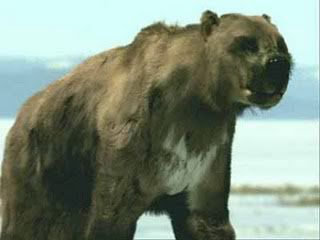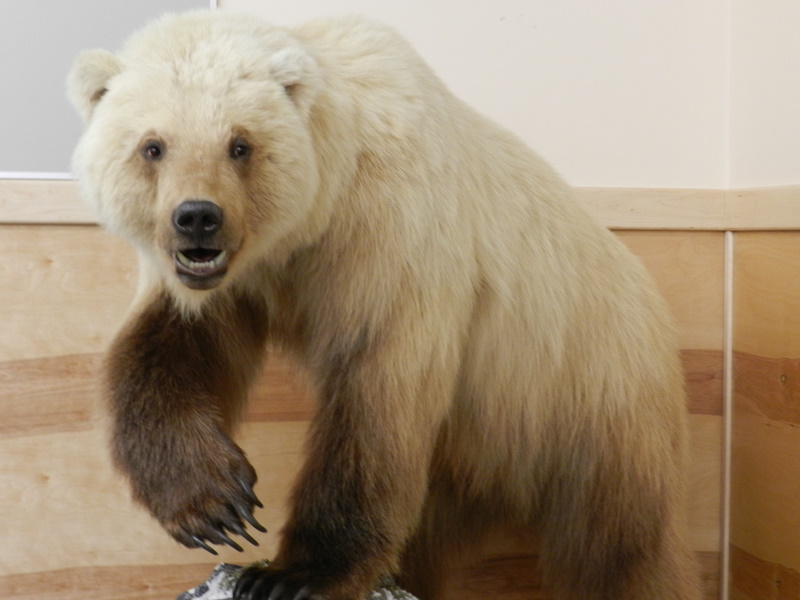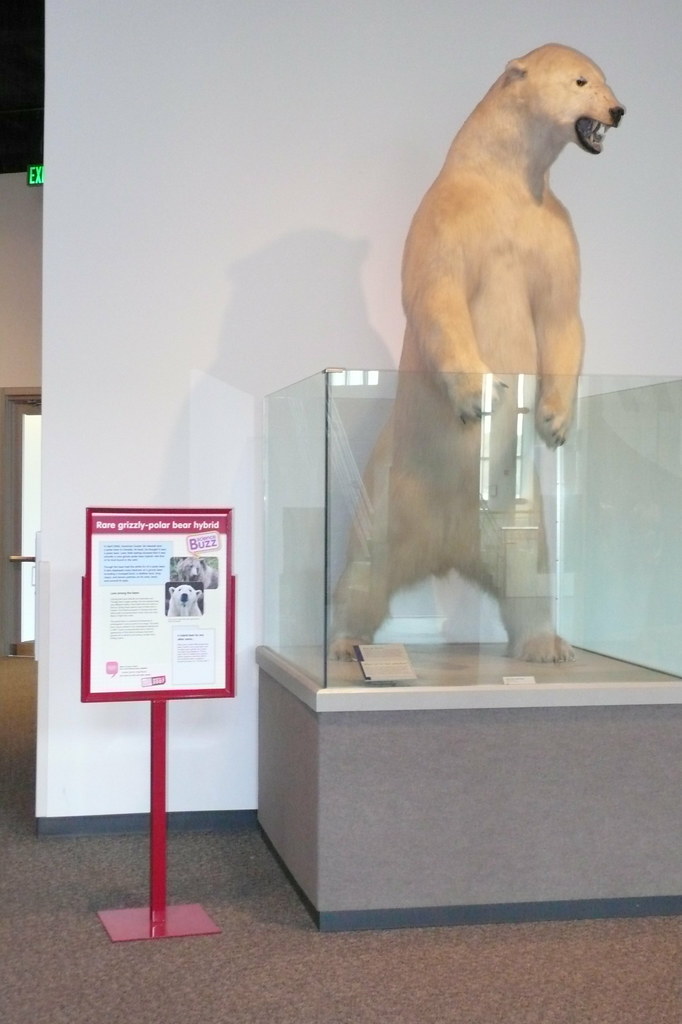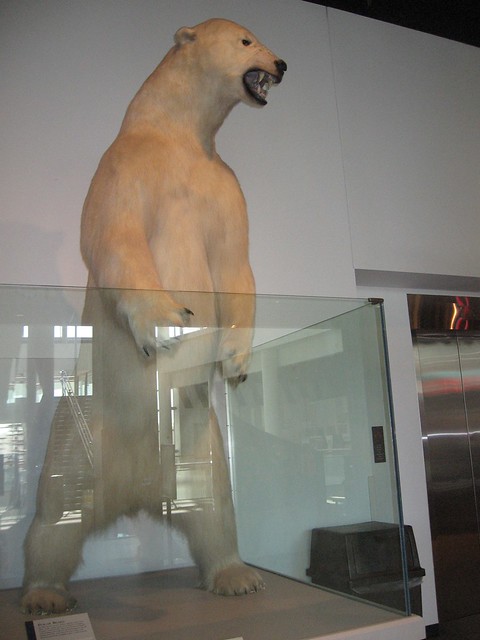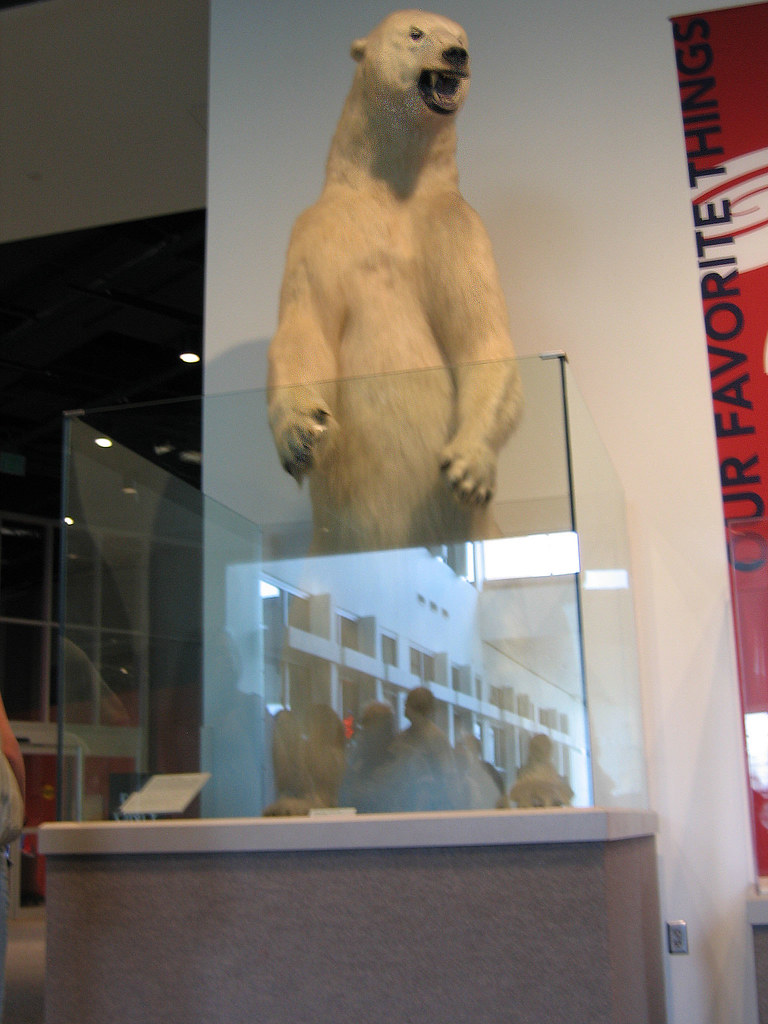Post by grrraaahhh on Apr 21, 2010 5:57:24 GMT -9
This person has created a very interesting web site (see post ending link) and has done a stand up job on hybrid bears which merits broader exposure and recognition:
HYBRID BEARS
The black bear and the European brown bear bred in the London Zoological Gardens in 1859, but the three cubs did not reach maturity. In "The Variation Of Animals And Plants Under Domestication" Charles Darwin noted: "In the nine-year Report it is stated that the bears had been seen in the Zoological Gardens to couple freely, but previously to 1848 had most rarely conceived. In the Reports published since this date three species have produced young (hybrids in one case) [...]" Hybrids between the brown bear and the grizzly-bear (considered by some to be a form of brown bear rather than a species) have been produced in Cologne, whilst at Halle since 1874 a series of successful matings of polar bears and brown bears have been made. Examples of these hybrid bears have been exhibited by the London Zoological Society. The hybrids between the brown and polar bears bred at Halle proved to be fertile, both with one of the parent species and with one another (details below). Polar bear/Brown bear hybrids are white at birth but later turn blue-brown or yellow-white.
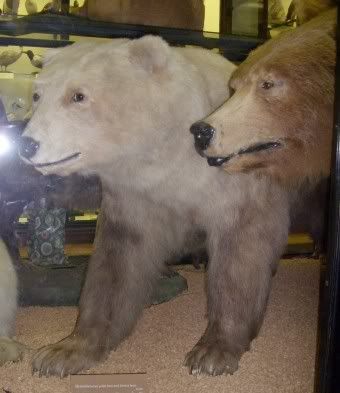
Hybrid of polar bear and brown bear at the Rothschild Zoological Museum.

Hybrid of polar bear and brown bear at the Rothschild Zoological Museum.
Crandall may have been unaware of the earlier Halle hybrids when he reported the first polar bear/brown bear cross as occurring at a small zoo in Stuttgart, Germany, where a female European brown bear (A. a. arctos) paired to a male polar bear gave birth to twin cubs in 1876. At least three further births were recorded, and the young were reported to have been fertile among themselves and when mated back to the parents or to animals of the same species as the parents. Full accounts of these experiments were given by Rong (1903) and Scherren (1907). Crandall noted that later interest was focused on the National Zoological Park where a female Alaskan brown bear (Ursus arctos gyas - William M Mann (1937)), mated with a polar bear and gave birth to three cubs in 1936. A second litter was born in 1939 to the same parents, although the female was then listed as middendorffi (Mann 1940). These cubs showed exceptional vigor and size, one male having reached a wieght of 1,160 pounds (Davis 1950). Two of the hybrid females were bred to a brother and produced several litters of cubs, of which some survived to maturity. A detailed account of these matings was given by Davis (loc. cit.) "
A male polar bear accidentally got into an enclosure with a female Kodiak (Alaskan Brown) bear at the US National Zoo in 1936 resulting in three hybrid offspring. One hybrid was named Willy and grew into an immense specimen. The hybrid offspring were fertile and able to breed successfully with each other (a male hybrid successfully bred with his 2 sisters), indicating that the two species of bear are closely related. In the National Geographic (Vol 137:4, April 1970) article "White Tiger in My House", Elizabeth C Reed mentions being foster mother to 4 hybrid bear cubs from the National Zoological Park in Washington where her husband was director. The second generation hybrids were brown with some white markings. DNA studies have apparently suggested that some brown bears are more closely related to polar bears than they are to other brown bears, raising an interesting question as to whether they are truly separate species. All the Ursinae species (all bears except the giant panda and the spectacled bear) appear able to crossbreed and will do so if placed together; all have 72 chromosomes except for Spectacled bears (53 chromosomes) and Pandas (42 chromosomes).
Clinton Hart Merriam, taxonomist of grizzly bears, came across one bear that was significantly different from other grizzlies. Believing it to be a living fossil, he named it Vetularctos inopinatus ("ancient, unexpected bear") in 1918. The nearly full-grown female bear had been killed by 2 Inuit hunters in 1864 at Rendezvous Lake, Barren Grounds, Canada and its skull and enormous yellowish skin acquired by naturalist Robert MacFarlane (leading to its popular name of MacFarlane's Bear). MacFarlane shipped these to the Smithsonian Institute where they remained forgotten in a store-room until Merriam rediscovered them. Although MacFarlane's speciment was only belatedly recognised as unusual, the Inuit had, and still have, stories about strange-looking bears.
Merriam described it as "buffy whitish" with a golden brown muzzle and suggested it came from a separate lineage to the Ursinae, being a modern descendent of the extinct giant short-faced bear and relative of the modern spectacled bears. The oddly shaped skull and teeth differ from that of both the Grizzly and the Polar bear, indicating it is not merely a colour morph of either species (blonde brown bears are known and some captive Polar bears take on a yellowish hue). Today it is variously considered a natural hybrid between a grizzly bear and polar bear or an aberrant form of grizzly, although DNA studies and morphological analysis of the skull have not been carried out. A similar bear was reported from Kodiak Island. The confirmation, in 2006, of a hybrid occurring in the wild led to renewed interest in MacFarlane's specimen.
In 1943, Clara Helgason described a bear seen during her childhood: hunters had shot a large, off-white bear with hair all over his paws. Some believed it to be a polar bear that had wandered far from its known range; others claimed it to be an albino Kodiak bear. The presence of hair on the bottom of the feet suggests it was not a Kodiak brown bear and it may have been a natural hybrid.
Natural polar/grizzly hybrids have been dubbed "pizzly", "grolar" or "polargrizz" bears. The Canadian government suggested the name "Nanulak", taken from the Inuit Nanuk (polar bear) and Aklak (grizzly bear). Taxonomists suggest "Ursus maritimus horribilis", "Ursus maritimus x horribilis" or "Ursus hibrada maritimus horribilis". Where bear populations have been reduced or where human encroachment on habitat forces the two species into closer proximity, such hybrids appear to be becoming more common. Grizzly bears have been sighted in polar bear territory in the Western Arctic near the Beaufort Sea, Banks Island, Victoria Island and Melville Island. A "light chocolate colored" bear, possibly a hybrid (although Grizzly bears can have colour variants) was reportedly seen with polar bears near Kugluktuk in western Nunavut.

In 2006, on Banks Island, 2000 km north of Edmonton, Canada, a sports hunter from Idaho shot a hybrid grizzly/polar bear. At first, Martell and his Inuit guides thought the animal was a polar bear, but closer inspection reveraled the features of a grizzly bear as well. The bear had thick, creamy white fur typical of a polar bear, but had the long claws, humped back and concave face of a grizzly bear. It's eyes were surrounded with rings of black fur and it had small brown patches of fur on its nose, back and one paw. The bear was one from a population at Sachs Harbour. The polar bear is a descendent of the grizzly bear (the grizzly is variable in colour and the palest bears would have had a survival advantage on the ice). A lab analysis of the DNA confirmed it was a hybrid. Analysis of mitochondrial DNA showed the mother to have been a polar bear and the father to have been a grizzly bear. With polar bears endangered, it is sad that $50,000 allows a trophy-hunter to kill one of these beasts. Other unusually coloured "polar" bears have been seen in the region and may also be hybrids. Polar bears normally give birth to two cubs and it is possible the shot hybrid has a a sibling.

In October 2009, a detailed study of captive-bred Polar x Grizzly hybrids by Alexandra Preuß (University of Osnabruck), Dr Ute Magiera (Osnabruck Zoo) and colleagues was published in the scientific journal Der Zoologische Garten. With only one verified hybrid seen in the wild, the study looked at 2 captive-bred hybrids out of the 17 hybrids known to exist in captivity. A few hybrid bears exist in zoos in the Czech Republic, Israel, Russia, Spain, Poland and Germany as a result of grizzly bears (a subspecies of brown bear) and polar bears being housed together. A study of hybrids born at Osnabruck Zoo, Germany confirms some of the previous observations regarding colouration and structure of the feet. It noted that hybrids inherited some distinct characteristics from either parent and some characteristics that were intermediate.
At Osnabruck Zoo, Germany, a male polar bear and female brown bear had been housed together since 1980, but not produced any cubs. After 24 years together, in January 2004, the female brown bear gave birth to two brown/polar bear hybrids, much to the surprise of Dr Ute Magiera, the zoo's conservation coordinator. Soon after their birth, the two hybrids were moved to another zoo, preventing them from learning any behaviours from either parent. The male was sterilised, but the female may prove fertile.
When adult, the hybrids were intermediate in size between the larger polar bear and the slightly smaller grizzly. They had the longer necks of polar bears, but small shoulder humps reminiscent of brown bears. The size and shape of their heads was intermediate between the thicker-set brown bear and the more slender-headed polar bear. They had visible tails, like polar bears (those of brown bears are almost invisible). The soles of their feet were partially covered in hair; polar bear feet are fully covered in insulating hair while brown bears have hairless soles with the toes clearly visible. A polar bear has hollow hair-shafts while the brown bear has solid hairs or hairs with small hollow regions. The hybrids' hair was intermediate having hollow pockets. The male hybrid had solid hair on its paws, but the dark hair on its back had hollow pockets. The female's hair had a range of hollow regions.
Having been separated from their parents, the cubs were not able to learn any behaviours from them. Their innate behaviour was similar to that of the polar bear. They used their front legs to stamp on large toys, much as polar bears stamp on ice to break into seal dens. They used their teeth to fling jute bages from side to side, just as polar bears fling prey around. In contrast, brown bears did not show this behaviour when playing with similar bags. Like polar pears, the hybrids lay down on their stomachs with hind legs spraddled (like a frog) when resting.
BLACK BEAR HYBRIDS
A hybrid between a Himalayan black bear and a North American black bear was supposedly born in the wild in the wild in Florida, after a Himalayan black bear escaped from a circus. According to Jack Hanna, author of "Monkeys on the Interstate" who helped wildlife officials capture the bear when it wandered into a residential area, "The bear was thought to be the offspring of a rare Himalayan sun bear [note: an error - Sun Bears are Malaysian] that had escaped from a circus several years back. He'd probably come down from the Ocala National Forest forty or fifty miles to the north, probably just walked right along the freeway. We released him back into the forest three weeks later. It was all tremendous publicity for the zoo.".
SLOTH BEAR X MALAYAN SUN BEAR, SLOTH BEAR X ASIATIC BLACK BEAR
A sloth bear was hybridised with a Malayan sun bear at the Tama Zoo, Tokyo, and also with an Asiatic black bear (Selenarctos thibetanus) (Gray, 1972; Asakura, 1969; Scherren, 1907).
Sloth bear x Malayan sun bear hybrids were reported by Shigeharu Asakura (General Curator, Tama Zoological Park, Tokyo, Japan) in "A Note On A Bear Hybrid - Melursus ursinus x Helarctus malayanus - at tama Zoo, Tokyo) published in 1969. The zoo had kept a pair of Malayan sun bears (Helarctus malayanus) in the same enclosure as some Sloth bears (Melursus ursinus) since they were young. They were all on friendly terms with no aggression between the individuals of the 2 species. About 5 earlier, there had been occasional sexual behaviour between the Sloth bears, but they had not bred. The Malayan Sun bears had shown no signs of sexual behaviour at this time, except for occasional unsuccessful mounting behaviour by the male.
On 12/06/1966, keeper Yoshio Takura observed a male Sloth bear copulating with a female Malayan Sun bear. 95 days after the mating, on 14/09/1966, the female produced a single male cub. The hybrid came to resemble the Sloth bear father in terms of hair, body shape and coloration.
SECOND GENERATION BEAR HYBRIDS
Instances of hybrid bears reaching maturity and being fertile have been reported by (Kowalska 1969; Wurster-Hill & Bush, 1980).
According to Zofia Kowalska (Scientific Assistant, Miejski Ogrod Zoologiczny w Lodzi, Lodz, Poland) in "A Note on Bear Hybrids: Thalarctos maritimus x Urus arctos", 4 sets of Polar bear x Brown bear hybrids were born at Lodz Zoo. The father was a Polar bear (Thalarctos maritimus) and the mother a Brown bear (Urus arctos).
* On 11/01/1961, 3 hybrids were born. 2 females survived.
* On 11/01/1962, 2 hybrids were born and survived, both female.
* On 11/01/1963, 4 hybrids were born, 1 male and 3 female, all survived.
* On 04/01/1965, 4 hybrids were born, 1 male and 3 female, all survived.
Note: This illustrates one aspect of Haldane's rule - the heterogamous sex (male in this case) being absent, rare or sterile; in this case more females were born and survived than males.
The parents had been housed together since 8 months old, were sexually mature at 64 months (5 years 4 months) and produced their first cubs at the age of 72 months (i.e. 6 years old). In the wild, male Polar bears do not reach sexual maturity until 8 years (Pederson, A, 1957; "Der Eisbär", Neue Brehm Büch. No 201: 1-64), but the Lodz Zoo's Polar bear impregnated the female when he was only 5 years old. Kowalska suggested the diet of captive Polar bears led to earlier sexual maturity.
Kowalska described the Lodz Zoo's hybris as all being much lighter in colour than the Brown bear while having the shape of the Polar bear. They all developed normally. A female hybrid from the 1961 litter mated with her Polar bear father in 1966 and on 20/12/1966 she produced a single male cub with nearly white fur. The other female from the 1961 litter was mated to a Brown bear in 1966 and on 19/12/1966 she produced 2 dark coloured male cubs, one having a light coloured head and neck. Kowalska submitted the report in June 1967 and it was published in 1969continued to monitor these 2nd generation hybrids and was particularly interested in their fertility.

More information:
Asakura, S. 1969: A note on a bear hybrid, Melursus ursinus x Helarctos malayanus, at Tama Zoo, Tokyo. Int. Zoo Ybk. 9:88.
Gray, A.P. 1972: Mammalian Hybrids. A Check-list with Bibliography. 2nd edition.
Kowalska, Z. 1962. "Intergeneric crossbreed of the brown bear Ursus arctos L., and the polar bear Thalarctos maritimus (Phipps)." Przeglad Zoologiczny, 6:230, 1 pl. [Polish with English summary.]
Kowalska, Z. 1965. "Cross breeding between a female European brown bear and a male polar bear in Lodz Zoo." Przeglad Zoologiczny, 9:313-319. [Polish with English summary.]
Kowalska, Z. 1969. "A note on bear hybrids Thalarctos maritimus and Ursus arctos at Lodz zoo." International Zoo Yearbook, 9:89.
Martin, P.L. 1876. "Ursus arctos and Ursus maritimus. On bastards between these species born in Nill's menagerie at Stuttgart." Zoologische Garten, 1876:20-22. [Zoologische Garten, 1877:135-136. W. Stendell and E. von Martens, tom. cit., pp.401-402.]
Martin, P.L. 1882. "On a hybrid between a male Ursus maritimus and a female Ursus arctos." Pederson, A, 1957; "Der Eisbär", Neue Brehm Büch. No 201: 1-64
Wurster-Hill, D.H. and Bush, M. 1980: The interrelationship of chromosome banding patterns in the giant panda (Ailuropoda melanoleuca), hybrid bear (Ursus middendorfi x Thalarctos maritimus), and other carnivores. Cytogenet. Cell Genet. 27:147-154.
Scherren, H.: Some notes on hybrid bears. Proc. Zool. Soc. London 431-435, 1907.
Alexandra Preuß, Udo Gansloßer, Günter Purschke and Ute Magiera. 2009: Bear-hybrids: behaviour and phenotype. Der Zoologische Garten Volume 78, Issue 4, 2009, Pages 204-220
www.messybeast.com/
HYBRID BEARS
The black bear and the European brown bear bred in the London Zoological Gardens in 1859, but the three cubs did not reach maturity. In "The Variation Of Animals And Plants Under Domestication" Charles Darwin noted: "In the nine-year Report it is stated that the bears had been seen in the Zoological Gardens to couple freely, but previously to 1848 had most rarely conceived. In the Reports published since this date three species have produced young (hybrids in one case) [...]" Hybrids between the brown bear and the grizzly-bear (considered by some to be a form of brown bear rather than a species) have been produced in Cologne, whilst at Halle since 1874 a series of successful matings of polar bears and brown bears have been made. Examples of these hybrid bears have been exhibited by the London Zoological Society. The hybrids between the brown and polar bears bred at Halle proved to be fertile, both with one of the parent species and with one another (details below). Polar bear/Brown bear hybrids are white at birth but later turn blue-brown or yellow-white.

Hybrid of polar bear and brown bear at the Rothschild Zoological Museum.

Hybrid of polar bear and brown bear at the Rothschild Zoological Museum.
Crandall may have been unaware of the earlier Halle hybrids when he reported the first polar bear/brown bear cross as occurring at a small zoo in Stuttgart, Germany, where a female European brown bear (A. a. arctos) paired to a male polar bear gave birth to twin cubs in 1876. At least three further births were recorded, and the young were reported to have been fertile among themselves and when mated back to the parents or to animals of the same species as the parents. Full accounts of these experiments were given by Rong (1903) and Scherren (1907). Crandall noted that later interest was focused on the National Zoological Park where a female Alaskan brown bear (Ursus arctos gyas - William M Mann (1937)), mated with a polar bear and gave birth to three cubs in 1936. A second litter was born in 1939 to the same parents, although the female was then listed as middendorffi (Mann 1940). These cubs showed exceptional vigor and size, one male having reached a wieght of 1,160 pounds (Davis 1950). Two of the hybrid females were bred to a brother and produced several litters of cubs, of which some survived to maturity. A detailed account of these matings was given by Davis (loc. cit.) "
A male polar bear accidentally got into an enclosure with a female Kodiak (Alaskan Brown) bear at the US National Zoo in 1936 resulting in three hybrid offspring. One hybrid was named Willy and grew into an immense specimen. The hybrid offspring were fertile and able to breed successfully with each other (a male hybrid successfully bred with his 2 sisters), indicating that the two species of bear are closely related. In the National Geographic (Vol 137:4, April 1970) article "White Tiger in My House", Elizabeth C Reed mentions being foster mother to 4 hybrid bear cubs from the National Zoological Park in Washington where her husband was director. The second generation hybrids were brown with some white markings. DNA studies have apparently suggested that some brown bears are more closely related to polar bears than they are to other brown bears, raising an interesting question as to whether they are truly separate species. All the Ursinae species (all bears except the giant panda and the spectacled bear) appear able to crossbreed and will do so if placed together; all have 72 chromosomes except for Spectacled bears (53 chromosomes) and Pandas (42 chromosomes).
Clinton Hart Merriam, taxonomist of grizzly bears, came across one bear that was significantly different from other grizzlies. Believing it to be a living fossil, he named it Vetularctos inopinatus ("ancient, unexpected bear") in 1918. The nearly full-grown female bear had been killed by 2 Inuit hunters in 1864 at Rendezvous Lake, Barren Grounds, Canada and its skull and enormous yellowish skin acquired by naturalist Robert MacFarlane (leading to its popular name of MacFarlane's Bear). MacFarlane shipped these to the Smithsonian Institute where they remained forgotten in a store-room until Merriam rediscovered them. Although MacFarlane's speciment was only belatedly recognised as unusual, the Inuit had, and still have, stories about strange-looking bears.
Merriam described it as "buffy whitish" with a golden brown muzzle and suggested it came from a separate lineage to the Ursinae, being a modern descendent of the extinct giant short-faced bear and relative of the modern spectacled bears. The oddly shaped skull and teeth differ from that of both the Grizzly and the Polar bear, indicating it is not merely a colour morph of either species (blonde brown bears are known and some captive Polar bears take on a yellowish hue). Today it is variously considered a natural hybrid between a grizzly bear and polar bear or an aberrant form of grizzly, although DNA studies and morphological analysis of the skull have not been carried out. A similar bear was reported from Kodiak Island. The confirmation, in 2006, of a hybrid occurring in the wild led to renewed interest in MacFarlane's specimen.
In 1943, Clara Helgason described a bear seen during her childhood: hunters had shot a large, off-white bear with hair all over his paws. Some believed it to be a polar bear that had wandered far from its known range; others claimed it to be an albino Kodiak bear. The presence of hair on the bottom of the feet suggests it was not a Kodiak brown bear and it may have been a natural hybrid.
Natural polar/grizzly hybrids have been dubbed "pizzly", "grolar" or "polargrizz" bears. The Canadian government suggested the name "Nanulak", taken from the Inuit Nanuk (polar bear) and Aklak (grizzly bear). Taxonomists suggest "Ursus maritimus horribilis", "Ursus maritimus x horribilis" or "Ursus hibrada maritimus horribilis". Where bear populations have been reduced or where human encroachment on habitat forces the two species into closer proximity, such hybrids appear to be becoming more common. Grizzly bears have been sighted in polar bear territory in the Western Arctic near the Beaufort Sea, Banks Island, Victoria Island and Melville Island. A "light chocolate colored" bear, possibly a hybrid (although Grizzly bears can have colour variants) was reportedly seen with polar bears near Kugluktuk in western Nunavut.

In 2006, on Banks Island, 2000 km north of Edmonton, Canada, a sports hunter from Idaho shot a hybrid grizzly/polar bear. At first, Martell and his Inuit guides thought the animal was a polar bear, but closer inspection reveraled the features of a grizzly bear as well. The bear had thick, creamy white fur typical of a polar bear, but had the long claws, humped back and concave face of a grizzly bear. It's eyes were surrounded with rings of black fur and it had small brown patches of fur on its nose, back and one paw. The bear was one from a population at Sachs Harbour. The polar bear is a descendent of the grizzly bear (the grizzly is variable in colour and the palest bears would have had a survival advantage on the ice). A lab analysis of the DNA confirmed it was a hybrid. Analysis of mitochondrial DNA showed the mother to have been a polar bear and the father to have been a grizzly bear. With polar bears endangered, it is sad that $50,000 allows a trophy-hunter to kill one of these beasts. Other unusually coloured "polar" bears have been seen in the region and may also be hybrids. Polar bears normally give birth to two cubs and it is possible the shot hybrid has a a sibling.

In October 2009, a detailed study of captive-bred Polar x Grizzly hybrids by Alexandra Preuß (University of Osnabruck), Dr Ute Magiera (Osnabruck Zoo) and colleagues was published in the scientific journal Der Zoologische Garten. With only one verified hybrid seen in the wild, the study looked at 2 captive-bred hybrids out of the 17 hybrids known to exist in captivity. A few hybrid bears exist in zoos in the Czech Republic, Israel, Russia, Spain, Poland and Germany as a result of grizzly bears (a subspecies of brown bear) and polar bears being housed together. A study of hybrids born at Osnabruck Zoo, Germany confirms some of the previous observations regarding colouration and structure of the feet. It noted that hybrids inherited some distinct characteristics from either parent and some characteristics that were intermediate.
At Osnabruck Zoo, Germany, a male polar bear and female brown bear had been housed together since 1980, but not produced any cubs. After 24 years together, in January 2004, the female brown bear gave birth to two brown/polar bear hybrids, much to the surprise of Dr Ute Magiera, the zoo's conservation coordinator. Soon after their birth, the two hybrids were moved to another zoo, preventing them from learning any behaviours from either parent. The male was sterilised, but the female may prove fertile.
When adult, the hybrids were intermediate in size between the larger polar bear and the slightly smaller grizzly. They had the longer necks of polar bears, but small shoulder humps reminiscent of brown bears. The size and shape of their heads was intermediate between the thicker-set brown bear and the more slender-headed polar bear. They had visible tails, like polar bears (those of brown bears are almost invisible). The soles of their feet were partially covered in hair; polar bear feet are fully covered in insulating hair while brown bears have hairless soles with the toes clearly visible. A polar bear has hollow hair-shafts while the brown bear has solid hairs or hairs with small hollow regions. The hybrids' hair was intermediate having hollow pockets. The male hybrid had solid hair on its paws, but the dark hair on its back had hollow pockets. The female's hair had a range of hollow regions.
Having been separated from their parents, the cubs were not able to learn any behaviours from them. Their innate behaviour was similar to that of the polar bear. They used their front legs to stamp on large toys, much as polar bears stamp on ice to break into seal dens. They used their teeth to fling jute bages from side to side, just as polar bears fling prey around. In contrast, brown bears did not show this behaviour when playing with similar bags. Like polar pears, the hybrids lay down on their stomachs with hind legs spraddled (like a frog) when resting.
BLACK BEAR HYBRIDS
A hybrid between a Himalayan black bear and a North American black bear was supposedly born in the wild in the wild in Florida, after a Himalayan black bear escaped from a circus. According to Jack Hanna, author of "Monkeys on the Interstate" who helped wildlife officials capture the bear when it wandered into a residential area, "The bear was thought to be the offspring of a rare Himalayan sun bear [note: an error - Sun Bears are Malaysian] that had escaped from a circus several years back. He'd probably come down from the Ocala National Forest forty or fifty miles to the north, probably just walked right along the freeway. We released him back into the forest three weeks later. It was all tremendous publicity for the zoo.".
SLOTH BEAR X MALAYAN SUN BEAR, SLOTH BEAR X ASIATIC BLACK BEAR
A sloth bear was hybridised with a Malayan sun bear at the Tama Zoo, Tokyo, and also with an Asiatic black bear (Selenarctos thibetanus) (Gray, 1972; Asakura, 1969; Scherren, 1907).
Sloth bear x Malayan sun bear hybrids were reported by Shigeharu Asakura (General Curator, Tama Zoological Park, Tokyo, Japan) in "A Note On A Bear Hybrid - Melursus ursinus x Helarctus malayanus - at tama Zoo, Tokyo) published in 1969. The zoo had kept a pair of Malayan sun bears (Helarctus malayanus) in the same enclosure as some Sloth bears (Melursus ursinus) since they were young. They were all on friendly terms with no aggression between the individuals of the 2 species. About 5 earlier, there had been occasional sexual behaviour between the Sloth bears, but they had not bred. The Malayan Sun bears had shown no signs of sexual behaviour at this time, except for occasional unsuccessful mounting behaviour by the male.
On 12/06/1966, keeper Yoshio Takura observed a male Sloth bear copulating with a female Malayan Sun bear. 95 days after the mating, on 14/09/1966, the female produced a single male cub. The hybrid came to resemble the Sloth bear father in terms of hair, body shape and coloration.
SECOND GENERATION BEAR HYBRIDS
Instances of hybrid bears reaching maturity and being fertile have been reported by (Kowalska 1969; Wurster-Hill & Bush, 1980).
According to Zofia Kowalska (Scientific Assistant, Miejski Ogrod Zoologiczny w Lodzi, Lodz, Poland) in "A Note on Bear Hybrids: Thalarctos maritimus x Urus arctos", 4 sets of Polar bear x Brown bear hybrids were born at Lodz Zoo. The father was a Polar bear (Thalarctos maritimus) and the mother a Brown bear (Urus arctos).
* On 11/01/1961, 3 hybrids were born. 2 females survived.
* On 11/01/1962, 2 hybrids were born and survived, both female.
* On 11/01/1963, 4 hybrids were born, 1 male and 3 female, all survived.
* On 04/01/1965, 4 hybrids were born, 1 male and 3 female, all survived.
Note: This illustrates one aspect of Haldane's rule - the heterogamous sex (male in this case) being absent, rare or sterile; in this case more females were born and survived than males.
The parents had been housed together since 8 months old, were sexually mature at 64 months (5 years 4 months) and produced their first cubs at the age of 72 months (i.e. 6 years old). In the wild, male Polar bears do not reach sexual maturity until 8 years (Pederson, A, 1957; "Der Eisbär", Neue Brehm Büch. No 201: 1-64), but the Lodz Zoo's Polar bear impregnated the female when he was only 5 years old. Kowalska suggested the diet of captive Polar bears led to earlier sexual maturity.
Kowalska described the Lodz Zoo's hybris as all being much lighter in colour than the Brown bear while having the shape of the Polar bear. They all developed normally. A female hybrid from the 1961 litter mated with her Polar bear father in 1966 and on 20/12/1966 she produced a single male cub with nearly white fur. The other female from the 1961 litter was mated to a Brown bear in 1966 and on 19/12/1966 she produced 2 dark coloured male cubs, one having a light coloured head and neck. Kowalska submitted the report in June 1967 and it was published in 1969continued to monitor these 2nd generation hybrids and was particularly interested in their fertility.

More information:
Asakura, S. 1969: A note on a bear hybrid, Melursus ursinus x Helarctos malayanus, at Tama Zoo, Tokyo. Int. Zoo Ybk. 9:88.
Gray, A.P. 1972: Mammalian Hybrids. A Check-list with Bibliography. 2nd edition.
Kowalska, Z. 1962. "Intergeneric crossbreed of the brown bear Ursus arctos L., and the polar bear Thalarctos maritimus (Phipps)." Przeglad Zoologiczny, 6:230, 1 pl. [Polish with English summary.]
Kowalska, Z. 1965. "Cross breeding between a female European brown bear and a male polar bear in Lodz Zoo." Przeglad Zoologiczny, 9:313-319. [Polish with English summary.]
Kowalska, Z. 1969. "A note on bear hybrids Thalarctos maritimus and Ursus arctos at Lodz zoo." International Zoo Yearbook, 9:89.
Martin, P.L. 1876. "Ursus arctos and Ursus maritimus. On bastards between these species born in Nill's menagerie at Stuttgart." Zoologische Garten, 1876:20-22. [Zoologische Garten, 1877:135-136. W. Stendell and E. von Martens, tom. cit., pp.401-402.]
Martin, P.L. 1882. "On a hybrid between a male Ursus maritimus and a female Ursus arctos." Pederson, A, 1957; "Der Eisbär", Neue Brehm Büch. No 201: 1-64
Wurster-Hill, D.H. and Bush, M. 1980: The interrelationship of chromosome banding patterns in the giant panda (Ailuropoda melanoleuca), hybrid bear (Ursus middendorfi x Thalarctos maritimus), and other carnivores. Cytogenet. Cell Genet. 27:147-154.
Scherren, H.: Some notes on hybrid bears. Proc. Zool. Soc. London 431-435, 1907.
Alexandra Preuß, Udo Gansloßer, Günter Purschke and Ute Magiera. 2009: Bear-hybrids: behaviour and phenotype. Der Zoologische Garten Volume 78, Issue 4, 2009, Pages 204-220
www.messybeast.com/

